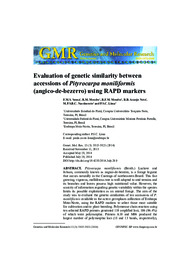Evaluation of genetic similarity between accessions of Pityrocarpa moniliformis (angico-de-bezerro) using RAPD markers.
Evaluation of genetic similarity between accessions of Pityrocarpa moniliformis (angico-de-bezerro) using RAPD markers.
Author(s): SOUSA, F. M. S.; MENDES, R. M.; MENDES, R. F. M.; ARAUJO NETO, R. B.; NASCIMENTO, M. P. S. B. C.; LIMA, P. S. C.
Summary: Pityrocarpa moniliformis (Benth.) Luckow and Jobson, commonly known as angico-de-bezerro, is a forage legume that occurs naturally in the Caatinga of northeastern Brazil. This fast growing, vigorous, melliferous tree is well adapted to arid terrains and its branches and leaves possess high nutritional value. However, the scarcity of information regarding genetic variability within the species limits its possible exploitation as an animal forage. The aim of the study was to evaluate the genetic similarities of ten accessions of P. moniliformis available in the active germplasm collection of Embrapa Meio-Norte, using the RAPD markers to select those most suitable for cultivation and/or plant breeding. Polymerase chain reaction using ten selected RAPD primers generated 110 amplified loci, 106 (96.4%) of which were polymorphic.
Publication year: 2014
Types of publication: Journal article
Unit: Embrapa Mid-North
Observation
Some of Embrapa's publications are published as ePub files. To read them, use or download one of the following free software options to your computer or mobile device. Android: Google Play Books; IOS: iBooks; Windows and Linux: Calibre.
Access other publications
Access the Agricultural Research Database (BDPA) to consult Embrapa's full library collection and records.
Visit Embrapa Bookstore to purchase books and other publications sold by Embrapa.

